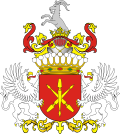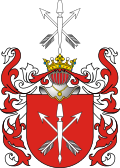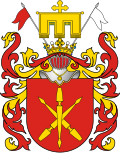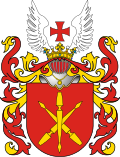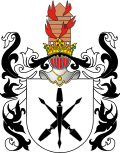A
Agewski, Ajewski, Alkiewicz, Anszeński, Antonowicz, Aszeński.
B
Badyński, Balowicz, Barczkowski, Białecki, Białocki, Białowiecki, Bielawski, Bielczewski, Bielski, Biesiad, Biesiadecki, Biesiadowski, Biesiadzki, Bilczewski, Bilczowski, Bliżyński, Bobrykiewicz, Boglewski, Bogurski, Bohyła, Bonin, Borzemski, Borzobohaty, Borzyński, Brodecki, Bukowiński, Bury, Buszkowski.
C
Chaiński, Chilchen, Chlebowicz, Chorążyna, Chuchrowski, Cielimoński, Cielimowski, Cielmowski, Cieluśnicki, Cieskanowski, Cieszanowski, Czeczel, Czeczela, Czeluściński, Czerkas, Czerkaski, Czerkawski, Czerkies, Czermieński, Czermiński, Czerniński, Czerszyński, Czerwakowicz, Czop, Czubka.
D
Dąbrowski, Dembowski, Derkaczowski, Dębowski, Dobrożyński, Dobryński, Dobrzyński, Dobuchowski, Drozdowski, Drożewski, Dubowieski, Duranowski, Dyss, Dziadowski, Dziaduski, Działowski, Dzibałtowski, Dziduski, Dziebałtowski, Dzieciątkowski, Dziewałtowski, Dziugłowski, Dziwisz, Dzyryt.
F
Faliński, Fanuel, Francuz[citation needed], Francuzewicz, Francuzowicz.
G
Gajewicz, Gajewski, Gawin, Gawlikowski, Gawłowski, Gąska, Gdeszycki, Gedytt, Gerdut, Gielitko, Gierdud, Gierecki, Giertut, Gierzyński, Gieszyński, Gintowt-Dziewałtowski, Girzyński, Glora, Głowa, Głowacki, Głowaczewski, Głupiecki, Godell, Godzianowski, Godziewski, Godziński, Goliszewski, Gołocki, Gomoliński, Goniprowski, Gorlewski, Gorliwski.
H
Halczyniecki, Hałoski, Hałowski, Held, Helt, Homolicki.
I
Idaszewski, Idzelewicz, Idzellewicz, Inowłodzki, Iskrzycki, Iwonia.
J
Jabłoński, Jacewicz, Jackiewicz, Jagiełłowicz, Jajkowski, Jakliński, Jakowicki, Jakowicz, Jakowiecki, Jaksztowicz, Janicki, Jankiewicz, Jankowski, Jarosławski, Jasieński, Jasiński, Jaworski, Jaykowski, Jazdowski, Jekliński, Jelita, Jelitko, Jelitowski, Jerzbutowicz.
K
Kaczorowski, Kaleński, Kalina, Kalino, Kaliński, Kaliski, Kalisz, Kałowski, Kamisowski, Kamocki, Kamyszowski, Kaufman, Kędzierzyński, Kępiński, Kicki, Kisielewski, Kliszewski, Kliszowski, Kliziński, Kluszczyński, Kmita, Knyszyński, Kobielski, Kochlewski, Kolbrzyński, Kołyszka, Kołyszko, Komornicki, Konstantynowicz, Kopijewicz, Koprzywnicki, Korytko, Korytkowski, Korytnicki, Korytowski, Korzyński, Kosowski, Kossowski, Koślarowski, Kotlicki, Kowalowski, Koziarowski, Kozielecki, Kozierowski, Koziołkowski, Koziołowski, Koźlarowski, Koźloróg, Kórzyński, Kraiński, Krasieński, Krasowski, Krassowski, Kropiński, Kropiwnicki, Krzęcki, Kuczyński, Kuncewicz, Kusiecki, Kwiatkiewicz, Kwiatkowicz.
L
Lapczyński, Lasochowski, Lasota, Lassochowski, Lassota, Leniecki, Lganowski, Libicki, Libidzki, Litosławski, Litwinowicz, Litwiński, Lneżeliński, Lochiński, Lochński, Lochyński, Lubecki, Lubicki, Luczeliński, Luczyliński, Luczywiński, Ludkiewicz, Lutkiewicz, Lutkowicz, Lutosławski, Lutostański, Lutoszewski.
Ł
Łańczyński, Łapczeński, Łapczyński, Łapiński, Łaziński, Łaźnicki, Łaźniński, Łażnicki, Łażniński, Łącki, Łęcki, Łochański, Łochiński, Łochyński, Łodygowski, Łodykowski, Łohyński, Łotocki, Łuczeliński, Łuczyleński, Łuczywiński, Łukiewicz, Łukowicz, Łukowski.
M
Machnicki, Madurowicz, Majeranowski, Majkowski, Makowski, Makułowicz, Malecki, Maljewski, Małecki, Marcinkowski, Marowicki, Martynowski, Marzęcki, Matecki, Matkiewicz, Micewicz, Michałowski, Michaniewski, Miczewicz, Miekaniewski, Mierski, Mietelski, Minczewski, Mirski, Misiekiewicz, Misiewicz, Misiewski, Misiowski, Misiurewicz, Missiewicz, Missowicz, Mniński, Mniszek, Modrzewski, Mojaczewski, Mojkowski, Mokrski, Mongin, Moraniecki, Moraniewski, Morawicki, Morawiecki, Morawieński, Morowiński, Moroz, Morozewicz, Morozowicz, Morozsz, Moszczański, Moszczeński, Moykowski, Mrawiński, Mrowiński, Mszerewicz, Myszejko, Myszeyko, Myśliborski, Myślicki.
N
Neronowicz, Nieronowicz, Niewiadomski, Nowosielecki, Nurowski.
P
Pabianowski, Pacanowski, Pachołowiecki, Padarewski, Paderewski, Pagiewski, Pajewski, Pajowski, Palski, , Pawłowski, Peczlewicz, Peczulewicz, Pełczyski, Perlicki, Pęczycki, Pieczkowski, Pieczulewicz, Pieczykowski, Pieniążek, Pietuch, Pijakowski, Piottuch, Piotuch, Piszkowicz, Piwakowski, Plachowicz, Podgórski, Podstękalski, Podstolski, Pokrzywnicki, Poleski, Popczyński, Popławski, Postękalski, Poznański, Pozylewicz, Pratkowski, Promieński, Promiński, Promnicki, Proniewicz, Proszczyński, Przybyłowski, Pudelski, Pudłowski.
R
Raciborowski, Raczkowski, Radogoscki, Radogoski, Radoszkowski, Rafalski, Raj, Rajczenko, Rajski, Rampalski, Ray, Rayski, Remiesz, Remiszewski, Remiszowski, Reszczewski, Romaszewski, Romer, Romiszewski, Romiszowski, Rosowski, Rospąd, Rospęd, Rozdziałowski, Rozniecki, Rozpąd, Rożniecki, Rożnowski, Rudlicki, Rychcicki, Rychczycki, Rykaczewski, Rymgayło, Rymgayłowicz, Rzepliński.
S
Sadowski, Salecki, Sancygniowski, Saryusz, Sczerbic, Sczukocki, Secygniewski, Secygniowski, Sędzigniewski, Sieliski, Sielnicki, Sietecki, Silnicki, Skarbek, Skąpski, Skępski, Skierko, Skokocki, Skokowski, Skorkowski, Skórkowski, Skrzynicki, Skrzyniecki, Slowiński, Sławianowski, Słupski, Sokolnicki, Sokołowicz, Sołowicki, Sołowiński[citation needed], Stanowski, Staropis, Stawirejski, Staworski, Stawowski, Stokowski, Strumecki, Strumieński, Strus, Struś, Strzałkowski, Strzeszkowski, Suchoczaski, Sudimont, Sudkiewicz, Sudymont, Sudywoj, Swarpłowicz, Swieczyk, Sypniewski, Sypniowski, Sypnowski, Syroczyński, Szadkowski, Szarski, Szczekocki, Szczepankiewicz, Szczepankowicz, Szczerbicz, Szczukocki, Szczurowski, Szpachiński, Szpakiński, Szpaliński, Szparkowski, Szubalski, Szydłowski, Szypieński.
T
Tarnawski, Tarnowski, Tatarski, Tchorzenicki, Tchorznicki, Terlikowski, Tomasz, Trawiński, Trzebiatowski, Tulicki.
U
Ul.
W
Wałowski, Wągleszyński, Werburt, Werbut, Węchadłowski, Węgleszyński, Wieloch, Wierzejski, Wierzyński, Wikoszewski, Wikszemski, Wilczkowski, Wilkoszewski, Wilkowski, Wilner, Witkowski, Witorowicz, Witoszyński, Witowicz, Wojciechowski, Wojnowski, Wojtkiewicz, Wolski, Wolski-Saryusz, Wolszleger, Worszyło, Woźnicki, Wrzesiński, Wrzeszyński, Wrześniowski, Wyłaski, Wyrzejski, Wyrzyski.
Z
Zakrzewski, Zakrzowski, Zaleski, Zalewski, Zamojski, Zamoyski, Zarszyński, Zawisza, Zboiński, Zbojeński, Zdunowski, Zdziechowski, Zelecheński, Zielawski, Zieliński, Zieliński-Saryusz, Zurowski.
��
Żarkowski, Żelawski, Żelecheński, Żelechowski, Żelechyński, Żelesiński, Żeleziński, Żeleżyński, Żełeżyński, Żeromski, Żurawski, Żurowski.


